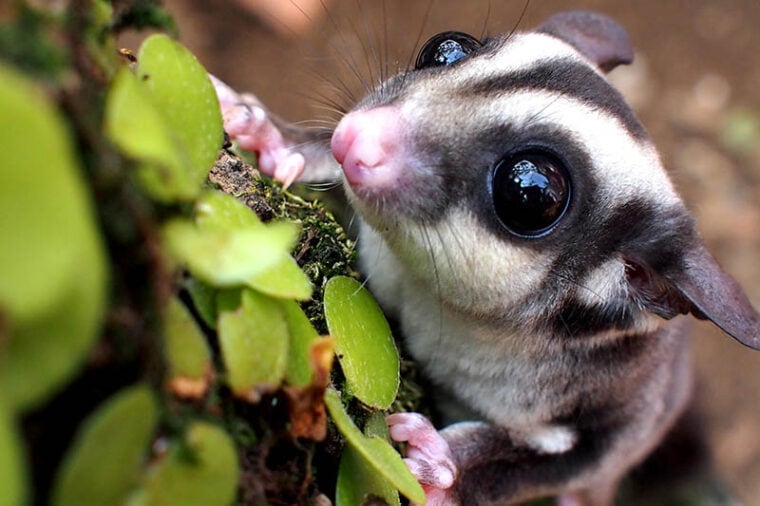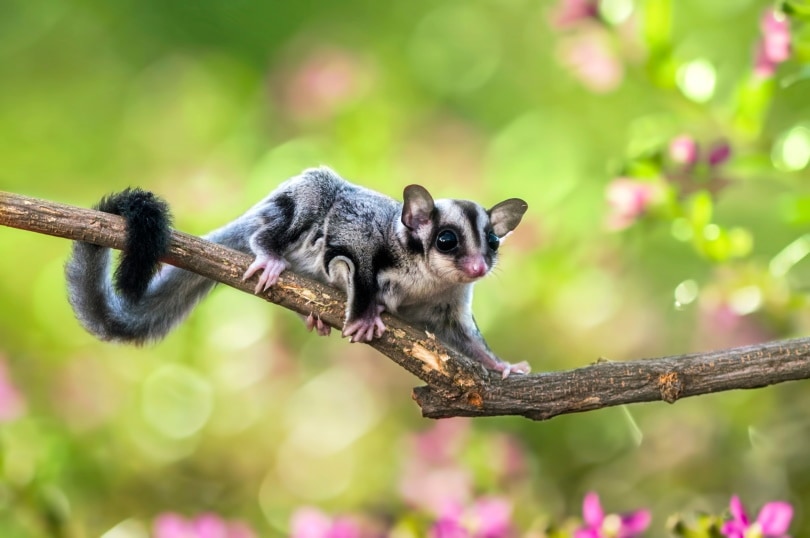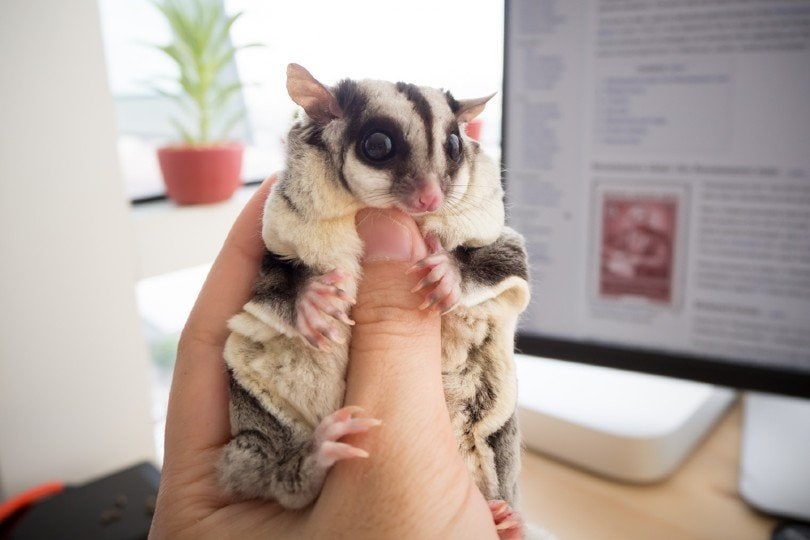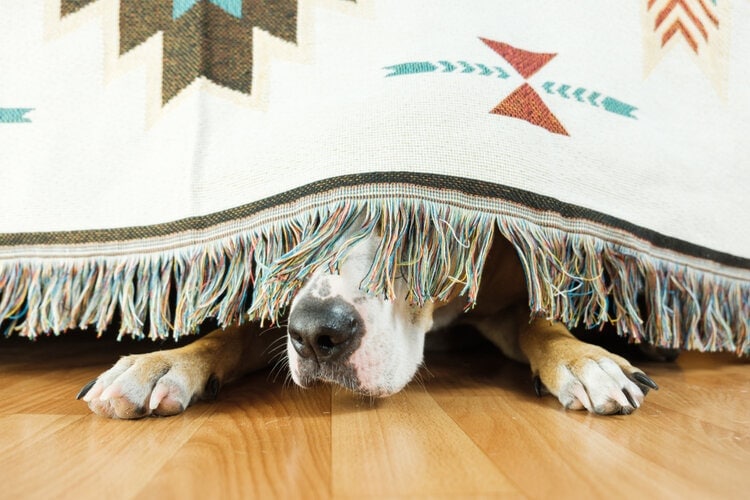
Sugar gliders are one of the most adorable and fascinating creatures you’ll ever come across. These small marsupials are native to Australia and Indonesia and are known for their adorable big eyes, furry tails, and their ability to glide through the air. They’re often kept as pets due to their gentle nature and unique behaviors.
Sugar gliders are incredibly social animals and thrive on interaction and companionship. They require a lot of attention and care, but in return, they make wonderful and loyal pets. But do these adorable creatures bite? From fear and aggression to mere playfulness, there are various reasons why a sugar glider might bite. In this post, we’ll dive into the world of sugar gliders and learn more about their behavior, needs, and whether they pose a danger, even a small one, to their owners.
Do Sugar Gliders Bite?
Yes. Unfortunately, these small creatures can exhibit some challenging behavior, including biting. While sugar glider biting can be alarming, it’s crucial to understand that it’s a natural behavior that can stem from various causes. Let’s look at some of them and potential solutions.
The 4 Common Causes of Sugar Glider Biting
Sugar gliders are social animals that require interaction with their owners to thrive. They also have a unique personality and behavior that can vary from one glider to another. Therefore, understanding the underlying causes of sugar glider biting can be challenging. Here are some of the most common reasons why sugar gliders bite.
1. Fear
Fear is one of the most common causes of sugar glider biting. Sugar gliders are prey animals, which means that they’re hardwired to be cautious and defensive. So, if they feel threatened or scared, they might bite as a defense mechanism. For example, if you approach your sugar glider too quickly or aggressively, it might perceive you as a predator and react by biting.
To prevent fear-based biting, it’s essential to approach your sugar glider slowly and calmly. Avoid sudden movements or loud noises that might startle your pet – especially if it’s a new pet. Also, try to establish trust and a bond with your sugar glider by spending time with it and offering treats and rewards.

2. Aggression
Aggression is another common cause of sugar glider biting. Although sugar gliders are generally friendly and social animals, they can become territorial or aggressive towards other gliders or humans. Male sugar gliders, in particular, can be more aggressive during mating season.
If your sugar glider is exhibiting aggressive behavior, it’s essential to identify the trigger and address it accordingly. For example, if your sugar glider is aggressive towards another glider, it might be necessary to separate them or provide more space and resources. If your sugar glider is aggressive towards you, it might be necessary to establish boundaries and reinforce positive behavior.
3. Playfulness
Believe it or not, sugar gliders can also bite out of playfulness. Sugar gliders are active and curious animals that love to explore and play. However, sometimes their playfulness can turn into nipping or biting (just like dogs), especially if they are overstimulated or excited.
To prevent playful biting, it’s essential to provide your sugar glider with enough stimulation and playtime. However, you should also establish boundaries and teach your sugar glider what is appropriate and what is not. So, for example, you can use toys or treats to redirect your sugar glider’s attention when it starts to bite or nip.

4. Health Issues
Sometimes, sugar gliders might bite because they are not feeling well. Health issues such as dental problems, infections, or injuries can cause pain and discomfort that might make your sugar glider more irritable or aggressive. Therefore, it’s crucial to monitor your sugar glider’s health and behavior regularly.
If you suspect that your sugar glider is biting because of a health issue, it’s important to seek veterinary care immediately. A qualified vet can diagnose and treat your sugar glider’s condition and provide you with advice on how to manage the biting behavior.
How to Prevent Sugar Glider Biting
Preventing sugar glider biting requires early socialization, bonding, and training. Here are some practical tips to help you prevent sugar glider biting.
Early Socialization
Like with dogs, early socialization is the key to preventing fear-based biting in sugar gliders. Socializing your sugar glider from a young age can help it establish trust and a bond with you and other humans. It can also help your sugar glider become more comfortable and confident in new environments and situations.
To socialize your sugar glider, you should handle it regularly and gently. Offer treats and rewards to reinforce positive behavior and avoid punishment or negative reinforcement. You should also introduce your sugar glider to different people, animals, and environments gradually and in a controlled manner.

Bonding
Bonding is another essential aspect of preventing sugar glider biting. Bonding involves spending time with your sugar glider and establishing a close relationship based on trust and affection. Bonding can help your sugar glider become more comfortable and secure around you, which can reduce the risk of biting.
To bond with your sugar glider, you should spend time with it every day. You can hold it on your lap, play with it, or simply sit near its cage and talk to it. You should also offer treats and rewards to reinforce positive behavior, such as coming to you when called or climbing onto your hand.
Training
Training can also help prevent sugar glider biting by teaching your pet what is appropriate and what isn’t. This can also help your sugar glider become more obedient and responsive to your commands, which can reduce the risk of biting.
To train your sugar glider, you can use positive reinforcement techniques such as clicker training or reward-based training. You should also start with simple commands, such as coming to you when called or sitting on your hand, and gradually increase the difficulty. You should also be patient and consistent and avoid punishment or negative reinforcement.
How to Manage Sugar Glider Biting
Managing sugar glider biting requires handling techniques, positive reinforcement, and distraction. Here are some practical tips to help you manage sugar glider biting.
Handling Techniques
Handling techniques can help you manage sugar glider biting by reducing the risk of injury and preventing fear-based biting. When handling your sugar glider, you should use a gentle and firm grip and avoid squeezing or restraining it. You should also avoid grabbing your sugar glider by the tail, as this can cause pain and injury.
If your sugar glider starts to bite, you should remain calm and avoid jerking your hand or pulling away. Instead, you should gently blow on your sugar glider’s face or offer a distraction, such as a toy or treat. You should also avoid punishing or scolding your sugar glider, as this can make the behavior worse.

Positive Reinforcement
Positive reinforcement can also help you manage sugar glider biting by reinforcing positive behavior and reducing the risk of aggressive or fear-based biting. So, this involves rewarding your sugar glider for good behavior, such as coming to you when called or sitting on your hand.
To use positive reinforcement, you should offer treats and rewards immediately after your sugar glider exhibits positive behavior. You should also use a consistent and clear reward system, like a clicker or a verbal cue, to reinforce the behavior. And again, avoid punishing or scolding your sugar glider.
Distraction
Distraction can also help you manage sugar glider biting by redirecting your pet’s attention and reducing the risk of playful or overstimulated biting. When your sugar glider starts to bite, you should offer a distraction, such as a toy or treat, to redirect its attention.
To use distraction, you should have a variety of toys and treats available for your sugar glider. You should also rotate the toys and treats regularly to keep your sugar glider interested and engaged. You should also avoid using your hands or fingers as toys, as this can encourage biting.

Understanding Sugar Glider Body Language
Understanding sugar glider body language is essential for identifying signs of stress, fear, and aggression. Sugar gliders communicate through a variety of body signals, such as posture, vocalization, and scent marking.
Here are some common signs of sugar glider body language:
Conclusion
In conclusion, sugar glider biting can be a challenging behavior to manage, but it’s essential to understand that it’s a natural behavior that can stem from various causes. By understanding the underlying causes and implementing practical solutions, you can prevent and manage sugar glider biting and ensure a happy and safe relationship with your furry friend. With patience, training, and consistency, you can enjoy a long and rewarding relationship with your sugar glider.
Featured Image Credit: acr23, Shutterstock







